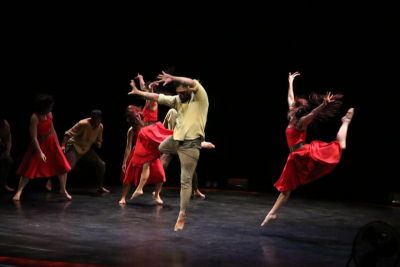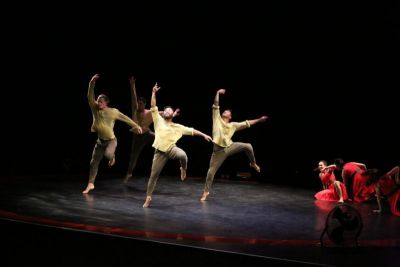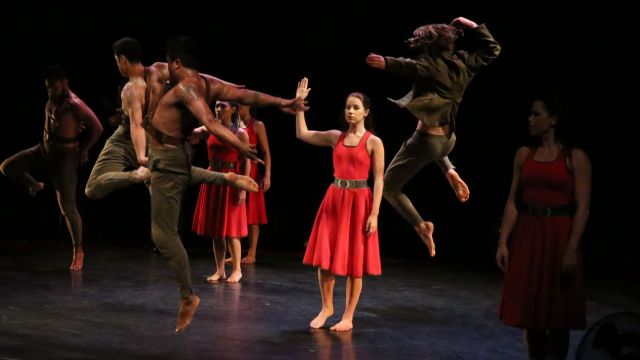Rotunda
Timed to honour the Gallipoli landings in 1915, Rotunda brings together contemporary dance and the haunting role that brass bands have played in farewelling servicemen (often from the rotundas in parks in country towns) as they left for the front – and accompanying them again as they march, year after year, to remember the fallen.
Created by Shona McCullagh (Artistic Director) and Don McGlashan (Musical Director), this is a moving piece of dance theatre that is poignant not just because of its message, but because the message is portrayed so differently and so gently. The narrative is strong, told in beautifully choreographed symbolic movement that encompasses the story of those who went, heroically, to fight, and those they left behind.
With the music of the City of Holroyd Brass Band conducted by Marc Taddei, and the extraordinary talent of percussionist Cameron Lee, eight dancers take the audience through a gambit of emotions as they “celebrate the ANZAC spirit and the themes of courage, loss, kinship and, ultimately, a desire for peace”.
 The dancers are athletic, poised and lithe, working together in rhythmic harmony that is at one moment fast and earthily expressive, the next soft and intimately knowing. There are some incredible examples of physicality, none more enthralling than a segment of mace twirling where the four male dancers mix choreographic dexterity, humour and split second timing.
The dancers are athletic, poised and lithe, working together in rhythmic harmony that is at one moment fast and earthily expressive, the next soft and intimately knowing. There are some incredible examples of physicality, none more enthralling than a segment of mace twirling where the four male dancers mix choreographic dexterity, humour and split second timing.
Symbols impregnate the performance. The audience is greeted by a projection of names of lost sons on a long piece of translucent fabric hanging from high above the stage. As the lights go down, fourteen electric fans catch the fabric as it is released and send it drifting and floating above and about a sole figure in a great coat, a red poppy in the lapel. From these first moments there is the clear suggestion of the elusiveness of life and of memory.
Moments later, the band enters from the sides of the theatre – once again suggesting past times and memorial services as they march onto the stage and take their places behind the dancers. Later in the story, as they grieve, the female dancers walk slowly to some band members, take their instruments and place them, like headstones, around the graveyard of the stage. These are compelling moments, given great strength by the compassion of the performers.
 In another symbolic moment, four translucent screens drop to allow a mixture of shadow play and projection that emphasises the enormity of combat. Once again, the fans pick up the pieces of fabric as they are released, lifting them like wispy memories to be caught, held and stored away.
In another symbolic moment, four translucent screens drop to allow a mixture of shadow play and projection that emphasises the enormity of combat. Once again, the fans pick up the pieces of fabric as they are released, lifting them like wispy memories to be caught, held and stored away.
Much thought has gone into the creating the theatricality of this interpretation of war and remembrance. The choreography is intricate, weaving history and music and movement as fine contemporary dance can. It is incredibly moving – because of the talent, passion and intensity of its performers … dancers and musicians alike – and because it tells an important story in such a different and beautiful way.
Carol Wimmer
Photographer: Caroline Bindon.
Subscribe to our E-Newsletter, buy our latest print edition or find a Performing Arts book at Book Nook.

